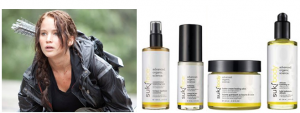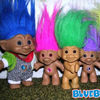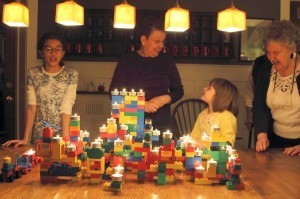Peggy Orenstein's Blog, page 7
March 21, 2012
Panem-is-Us? Thoughts on "The Greed Games"
Ah, the ironies of our media culture. First the film version of "The Lorax" commercialized anti-consumerism by pimping out its namesake to seventy corporate sponsors (including IHOP pancakes and Mazda cars).
Now comes the deluge of "Hunger Games"-inspired products that are so contrary to the books' message that they seem like a parody. Take the press release I received today:
SAVING FACE in The Hunger Games – Best Beauty Solutions to Shed the 'Tribute Tomboy'
Hi Peggy,
Hope you're doing well! In just two days the world will be watching as Jennifer Lawrence, Josh Hutcherson and the rest of their star-studded cast take center stage in The Hunger Games… so with all the hype surrounding the premiere, I figured you might enjoy this fun story idea!
Fighting to the death doesn't always end pretty (case in point, Glimmer's notorious tracker jacker scene), but Katniss Everdeen made it look so easy, right? Through the scrapes and scars, burns and bruises, torn limbs and tattered clothes, the Tribute 12 huntress maintained her Amazonian prowess, with the same composure and "soft, rosy glow" radiance that Cinna + his beauty squad sent her to the Cornucopia with.
Yet for the rest of us, who aren't quite mockingjay material, looking great at the end of a grueling "battle royale" might enlist extra help. The Careers would probably just use nature to concoct these mystifying beauty elixirs, but competitors who are aren't such DIY-ers, should just hope for these products in their survival packs….
Let me know if you're interested in more information on the below products for any emergency/life-saver beauty pieces you might be working on.
Looking forward to your thoughts!
Danielle
Exhaustion/Dehydration Post-Cornucopia Bloodbath (sukiface® Balancing Day Lotion) – this lightweight, inflammation soothing daily complexion hydrator formulated with comfrey and aloe calms skin irritations, relieves redness and helps balance oil protection (from a full day of sweat and tears, you'll need it). $35.95/sukiskincare.com
Attack of the Tracker Jackers (sukiface® Concentrated Balancing Toner) - this potent and powerful anti-inflammatory and antibacterial vitamin C complexion tincture/tonic calms and soothes minor bug bites and even the horrific sting of the tracker jacker. Also great as a refreshing mist/after-sun spray to cool off after your hallucinogenic romp in the sun has died down. $32.95
Tired, Weary, Scarred and Scorched (sukibody® Butter Cream Healing Salve) – this intensely hydrating, non-greasy therapeutic botanical balm infused with coconut oil is ideal for alleviating the worst rashes (and poison ivy?), treating scars and scrapes, and healing chapping/chaffing brought on by severe dehydration. Great to have on hand if your sponsor isn't doing his job… $27.95
Let it Rain (sukibody® Delicate Hydrating Oil) – it might not be the safest decision to dance in the rain once the sky opens up, but for the first few minutes freshen up with this lavender-infused therapeutic moisturizing bath oil… can also be used as a great massage oil if you have some alone time to kill in a cave… $27.95
Here are my thoughts, Danielle: Somewhere the "real" Katniss is weeping. Or laughing. Or putting her head down and just getting on with it. (And "Tribute Tomboy?" What does that even mean?)
But don't despair: given how many thousands of girls love The Hunger Games series, this is a fabulous opportunity for a media literacy discussion, for imagining how Katniss–all buffed and glossed and ready to be forced to BATTLE OTHER CHILDREN TO THE DEATH for the entertainment of the decadent Capitol denizens and their sadistic president–might feel about these products; to consider about how our media and beauty culture is glorifying the Panemites, making Hunger Games about something other than what it is (and how we can channel our inner Katniss to fight back).
One idea: Powered By Girl offers young women a chance to talk back to media by spoofing ads in a fun, funny, creative way. How about doing your own PBG-ing on some of the Hunger Games product ads like this one for "Capitol Colors" nail polish (each color reflects one of the Districts!)? With whom are we to identify here?
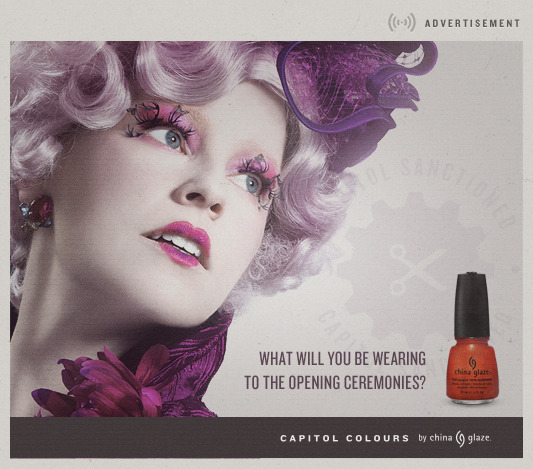
What better way to be the Mockingjay than to mock?
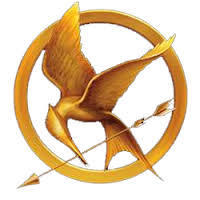
March 17, 2012
Fat is a Preschool Issue
Yesterday I posted a link on my facebook page to an article on CNN.com called "Fat is the New Ugly on the Playground," which featured a few nice quotes by yours truly. In response to the post were comments including the following:
Excuse me in my experience fat has always equalled ugly on the playground, ain't nuthin new here, take it from a former fat kid.
'Fat' has always been ugly on the playground, or any where else for that matter!
I'm not sure why this is all of a sudden breaking news.
Absolutely true. Fat kids—boys as well as girls—have long been tormented, demonized and excluded by their schoolmates. In CAMD I talk about the history of American attitudes towards fat—the reasons it came to be seen as a moral issue, a character flaw; how it became particularly taboo for women whose avoirdupois was once considered sexy. Check out an exotic dancer in the 1800s:
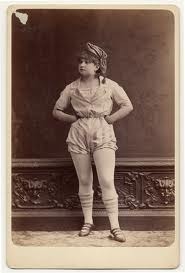
I struggle openly in CAMD and elsewhere over how to imbue a daughter with a healthy body image. In fact, I've been writing about women and weight since the late 1980s, so it's not like any of this is a surprise.
What's new, however, is the ever-earlier age at which children—girls particularly– become conscious of weight. In Schoolgirls I cited a study revealing that 50% of 9-year-old girls were dieting (check this Wall Street Journal article by a reporter who, to see for himself, interviewed a group of girls when that study came out; he talked to them again recently as adults). But now, it appears, by age three girls equate thinness with beauty, sweetness, niceness and popularity; they associate "fat" meanwhile with laziness, stupidity and friendlessness.
Yes, I said three. In a 2010 study researchers engaged 3-5 year old girls in games of Candyland and Chutes & Ladders asking them to choose among three game pieces–a thin one, an average-sized one and a fat one–to represent themselves. While in the past children that age showed little ability to distinguish between average and thin weights, today's wee ones grabbed thin pieces at higher rates not only than fat ones but than those of "normal" weight. When asked by researchers to swap a thin figure for a fat one, the girls not only recoiled but some refused to even touch the chubbier game piece making comments such as, "I hate her, she has a fat stomach," or "She is fat. I don't want to be that one."
Again: preschoolers.
As I've written before on this blog, toy manufacturers have lately classic toys on a diet, claiming (apparently rightly) that "Girls won't play with childlike dolls any more." So take a look:
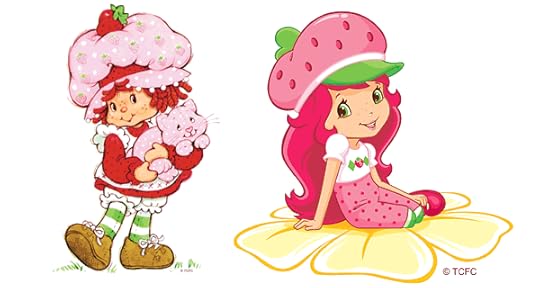

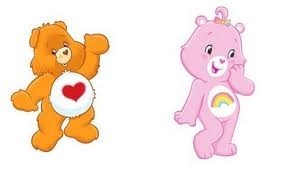
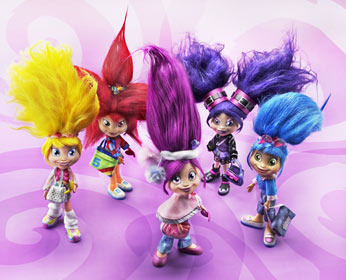
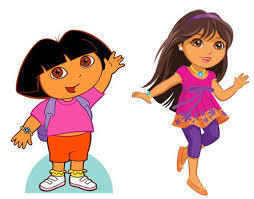
Our friends at Pigtail Pals, in a recent blog about this baby-fear-of-fat phenomenon posted a photo of how Barbie–whose figure has reflected the idealized female physique for decades–has also whittled her waist and hiked her heinie. Meanwhile, the doll's demographic has dropped: she's now marketed at 3-6 year olds (her original audience was 8-12).
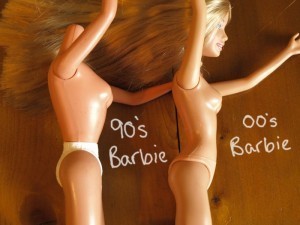
There's no more grace period. From the get-go girls are bombarded with images of women whose bodies range from unattainable to implausible (Disney Princesses, anyone?). Even G-rated films and educational TV present thinness not as healthier (which it may or not be, depending on how you get there) but morally superior.
Given the mental health vulnerabilities an ever-narrowing standard of beauty creates in our girls–not to mention the negative impact fat-shaming has on overweight kids–are we really okay with letting this slide?
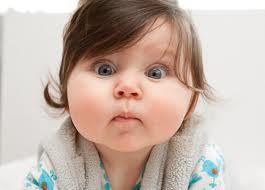
March 9, 2012
In Memoriam: Benedict and Nancy Freedman
Ben Freedman, my friend, inspiration and the co-author (with his wife Nancy) of my favorite book as a girl—Mrs. Mike-died on February 24 at the age of 92. I found out earlier this week when the New York Times obituary page called me for a quote.
Here is a picture of my original copy of Mrs. Mike, which I still have, held together by scotch tape and rubber bands.
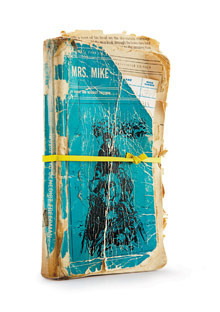
Ben and Nancy (who died in 2010) led rich, full lives—I loved going to their apartment to listen to stories of their adventures, schemes and foibles. Even in failing healthy, they were exuberant and intellectually engaged, full of plans for the future, still writing every single day.
In honor of their lives, and to mark their loss, here is a link to Ben's obituary.
And here is a link to a piece I wrote for Oprah Magazine about what they meant to me . I'm so grateful I had opportunity to write it—and even more grateful that I could do it while they were still around to read it.
Nancy and Ben were iconoclasts, free-thinkers, the ultimate champions of the "fight fun with fun" mentality. Nancy used to reminded me, "You have to celebrate bad news. Good news, you're happy anyway, but bad news–you've got to have a great dinner and kick up your heels."
May we all, like then, remember to kick up our heels.

February 28, 2012
Is it Contradictory to Embrace the “Princess Boy?”
In today’s Motherlode Emily Rosenbaum struggles with what seems to her to be a contradiction in the how she parents her daughter vs. her sons. The revelation was triggered when her 3-year-old girl returned from the Home Depot (with Emily’s husband) brandishing a Disney Princess light switch plate (in case you’re keeping track: that would be DP item #25,978 of the 26,000+ I mention in CAMD). It probably looked something like this:

Emily was furious, but her husband said:
You know, you’re reacting just the way I react when Zach wants to buy pink clothes. You should allow her to express herself as much as you let the boys do it.
That pulled Emily up short. Turns out their son, Zach, “is the only boy in his second-grade class to regularly rock a pink hoodie and pink socks. Benjamin spent his toddler years dressed as Tinkerbell, and we potty trained him by giving him plastic Disney princesses as reward.” What bothers her is the idea that her daughter is into pink and princess. “It’s a parenting Catch-22,” she writes:
We have excellent books like Peggy Orenstein’s Cinderella Ate My Daughter [Aw, gee, thanks, say I!] that deconstruct why princesses are so injurious to girls. Yet Cheryl Kilodavis’s My Princess Boy has us jumping up and down to support a boy’s right to like pretty things. We gag at nail polish marketed to children, yet we are delighted by a J. Crew ad featuring a boy in toenail polish.
Which is it? Are princesses bad for kids or part of their right to express themselves? Should we shield our children from the nefarious influence of cosmetics or embrace them?
I don’t necessarily see these positions as mutually exclusive. Because really, it’s not about “princesses.” It’s about recognizing the limitations our culture places on both girls and boys through its selling of very narrow ideas of femininity and masculinity.
So let’s unpack this a bit. Emily’s husband says girls are “expressing themselves” by buying into a $4 billion marketing blitz that is geared towards convincing girls this is the only way for them to act out femininity. Remember that developmentally, most 3-year-old girls do want to express their girlness (and boys their boyness). The princess industrial complex exploits and distorts that impulse. Take a look, for instance, at the winner of the contest I held when the CAMD paperback first came out. It’s one of the best illustrations I’ve seen of how today’s princess play flattens girls individuality and imaginations. They’re not ”expressing” femininity so much as latching onto one heavily marketed aspect that has been sold to an unhealthy extreme. I mean look at how many DP items there are at Home Depot alone! That’s not including non-Disney items (search princess instead of Disney Princess). What other choices are little girls offered?
That brings me to the second issue–the pendulum-swing we often engage in when we discuss this topic. The choices seem to be that a girl is either “expressing her femininity” by ensconcing herself in pink and princess or shunning ”girlie stuff” and sleeping with a football. To me the real task is to find a “third way” that exposes girls to and allows them expression of a broader, healthier range of ideas about femininity: ones that aren’t perpetually linked to appearance and consumerism and that aren’t putting them on a path to define themselves through that connection for the rest of their lives. That’s why I added the “fight fun with fun” section to this site–to offer at least some options for cultivating a different, celebratory, joyous vision of girls’ femininity that is unhooked from the current script.
Okay, now, onto the princess boy. Honestly, who doesn’t like a few sparkles? I put them on the cover of my book! Everyone should be able to indulge in a little dress-up occasionally. That said, celebrating the ”princess boy” is really about not wanting ANY of our children limited by stereotypes or denied the full range of human desires, emotions, enjoyments and potential. In our culture right now boys are actively discouraged from engaging in anything seen as “feminine,” which means they’re denied color, sparkles, art, aesthetics, music and many things that, once upon a time, were the province and right of both sexes. When we hyper-segment kids by gender everyone is hurt, everyone is limited. But there’s an additional issue when we teach boys they can’t play with “girl” things: they learn not only to disdain that which is associated with girls but to disdain girls themselves. Enforcing masculinity in childhood play is how we replicate misogyny and homophobia. Bad, bad juju.
Another way to think about it might be to flip it. You might be more comfortable buying your daughter a toy gun because violence is not marketed to her as the cornerstone of feminine identity. It might feel subversive, expansive, whereas you might fret that buying one for your son would reinforce the message that he’s supposed to be tough, hard, emotionless, cruel.
So it’s not about saying pink and sparkles are okay for boys and not girls, it’s about trying to navigate through a world of products and images that are hyper-segmented and unhealthy, promote stereotypes, alienation between the sexes, and limit kids’ access to the full spectrum of life. Emily, that’s a really, really good impulse on your part that the marketplace, in its simplicity, is trying to convince you is hypocrisy.
You’ve got so many opportunities to create change as the parent of both a girl and boys. Listen, a little self-decoration (henna tattoos, washable markers, face paint, glitter) is fun for all. Meanwhile, try to expose your children of both sexes to a wide range of ideas, toys, images, clothing. Rather than simply allowing Zack to wear pink, why not also read him the kind of stories about strong women and competent, clever girls that I’m sure you read to your daughter? If he likes to dress up as a Disney Princess, why not suggest a Greek goddess? Or Lucy from The Lion, the Witch, and the Wardrobe? Or Kiki from Kiki’s Delivery Service? How subversive would that be? Would that make you less comfortable than celebrating “the princess boy?” And if so, why? Perhaps that’s the real question.
Is it Contradictory to Embrace the "Princess Boy?"
In today's Motherlode Emily Rosenbaum struggles with what seems to her to be a contradiction in the how she parents her daughter vs. her sons. The revelation was triggered when her 3-year-old girl returned from the Home Depot (with Emily's husband) brandishing a Disney Princess light switch plate (in case you're keeping track: that would be DP item #25,978 of the 26,000+ I mention in CAMD). It probably looked something like this:

Emily was furious, but her husband said:
You know, you're reacting just the way I react when Zach wants to buy pink clothes. You should allow her to express herself as much as you let the boys do it.
That pulled Emily up short. Turns out their son, Zach, "is the only boy in his second-grade class to regularly rock a pink hoodie and pink socks. Benjamin spent his toddler years dressed as Tinkerbell, and we potty trained him by giving him plastic Disney princesses as reward." What bothers her is the idea that her daughter is into pink and princess. "It's a parenting Catch-22," she writes:
We have excellent books like Peggy Orenstein's Cinderella Ate My Daughter [Aw, gee, thanks, say I!] that deconstruct why princesses are so injurious to girls. Yet Cheryl Kilodavis's My Princess Boy has us jumping up and down to support a boy's right to like pretty things. We gag at nail polish marketed to children, yet we are delighted by a J. Crew ad featuring a boy in toenail polish.
Which is it? Are princesses bad for kids or part of their right to express themselves? Should we shield our children from the nefarious influence of cosmetics or embrace them?
I don't necessarily see these positions as mutually exclusive. Because really, it's not about "princesses." It's about recognizing the limitations our culture places on both girls and boys through its selling of very narrow ideas of femininity and masculinity.
So let's unpack this a bit. Emily's husband says girls are "expressing themselves" by buying into a $4 billion marketing blitz that is geared towards convincing girls this is the only way for them to act out femininity. Remember that developmentally, most 3-year-old girls do want to express their girlness (and boys their boyness). The princess industrial complex exploits and distorts that impulse. Take a look, for instance, at the winner of the contest I held when the CAMD paperback first came out. It's one of the best illustrations I've seen of how today's princess play flattens girls individuality and imaginations. They're not "expressing" femininity so much as latching onto one heavily marketed aspect that has been sold to an unhealthy extreme. I mean look at how many DP items there are at Home Depot alone! That's not including non-Disney items (search princess instead of Disney Princess). What other choices are little girls offered?
That brings me to the second issue–the pendulum-swing we often engage in when we discuss this topic. The choices seem to be that a girl is either "expressing her femininity" by ensconcing herself in pink and princess or shunning "girlie stuff" and sleeping with a football. To me the real task is to find a "third way" that exposes girls to and allows them expression of a broader, healthier range of ideas about femininity: ones that aren't perpetually linked to appearance and consumerism and that aren't putting them on a path to define themselves through that connection for the rest of their lives. That's why I added the "fight fun with fun" section to this site–to offer at least some options for cultivating a different, celebratory, joyous vision of girls' femininity that is unhooked from the current script.
Okay, now, onto the princess boy. Honestly, who doesn't like a few sparkles? I put them on the cover of my book! Everyone should be able to indulge in a little dress-up occasionally. That said, celebrating the "princess boy" is really about not wanting ANY of our children limited by stereotypes or denied the full range of human desires, emotions, enjoyments and potential. In our culture right now boys are actively discouraged from engaging in anything seen as "feminine," which means they're denied color, sparkles, art, aesthetics, music and many things that, once upon a time, were the province and right of both sexes. When we hyper-segment kids by gender everyone is hurt, everyone is limited. But there's an additional issue when we teach boys they can't play with "girl" things: they learn not only to disdain that which is associated with girls but to disdain girls themselves. Enforcing masculinity in childhood play is how we replicate misogyny and homophobia. Bad, bad juju.
Another way to think about it might be to flip it. You might be more comfortable buying your daughter a toy gun because violence is not marketed to her as the cornerstone of feminine identity. It might feel subversive, expansive, whereas you might fret that buying one for your son would reinforce the message that he's supposed to be tough, hard, emotionless, cruel.
So it's not about saying pink and sparkles are okay for boys and not girls, it's about trying to navigate through a world of products and images that are hyper-segmented and unhealthy, promote stereotypes, alienation between the sexes, and limit kids' access to the full spectrum of life. Emily, that's a really, really good impulse on your part that the marketplace, in its simplicity, is trying to convince you is hypocrisy.
You've got so many opportunities to create change as the parent of both a girl and boys. Listen, a little self-decoration (henna tattoos, washable markers, face paint, glitter) is fun for all. Meanwhile, try to expose your children of both sexes to a wide range of ideas, toys, images, clothing. Rather than simply allowing Zack to wear pink, why not also read him the kind of stories about strong women and competent, clever girls that I'm sure you read to your daughter? If he likes to dress up as a Disney Princess, why not suggest a Greek goddess? Or Lucy from The Lion, the Witch, and the Wardrobe? Or Kiki from Kiki's Delivery Service? How subversive would that be? Would that make you less comfortable than celebrating "the princess boy?" And if so, why? Perhaps that's the real question.
Princess Okay for Boys but not Girls? It’s Not Hypocritical
Yikes! I just realized I accidentally posted this twice. For the real version please see above. I will also copy the comments from this post into that one. Sorry!
Princess Okay for Boys but not Girls? It's Not Hypocritical
In today's Motherlode Emily Rosenbaum struggles with what seems to her to be a contradiction in her attitude toward her daughter and her son. The revelation was triggered when her 3-year-old daughter returned from the Home Depot (with Emily's husband) brandishing a Disney Princess light switch plate (in case you're keeping track: that would be DP item #25,978 of the 26,000+ I mention in CAMD).

Emily was furious, but her husband said:
You know, you're reacting just the way I react when Zach wants to buy pink clothes. You should allow her to express herself as much as you let the boys do it.
That pulled Emily up short. Turns their son Zach, "is the only boy in his second-grade class to regularly rock a pink hoodie and pink socks. Benjamin spent his toddler years dressed as Tinkerbell, and we potty trained him by giving him plastic Disney princesses as reward." What bothers her is the idea that her daughter is into pink and princess. "It's a parenting Catch-22," she writes:
We have excellent books like Peggy Orenstein's Cinderella Ate My Daughter [Aw, gee, thanks, say I!] that deconstruct why princesses are so injurious to girls. Yet Cheryl Kilodavis's My Princess Boy has us jumping up and down to support a boy's right to like pretty things. We gag at nail polish marketed to children, yet we are delighted by a J. Crew ad featuring a boy in toenail polish.
Which is it? Are princesses bad for kids or part of their right to express themselves? Should we shield our children from the nefarious influence of cosmetics or embrace them?
I don't see these positions as mutually exclusive. Because really, it's not about "princesses." It's about recognizing the limitations our culture places on both girls and boys through its selling of very narrow ideas of femininity and masculinity.
So let's unpack this a bit. Emily's husband says girls are "expressing themselves" by buying into a $4 billion marketing effort that has become the only way for them to embrace femininity. This in itself is problematic–take a look, for instance, at the winner of the contest I held when the CAMD paperback first came out. It shows how princess play flattens girls individuality and imaginations . So what they're "expressing" is not femininity, but one heavily marketed aspect that has been taken to an unhealthy extreme. I mean look at how many DP items there are at Home Depot alone! That's not including non-Disney items (search princess instead of Disney Princess). What other choices are little girls (who often want and need to assert that they are little girls) offered?
That brings me to the second issue–stopping the pendulum-swing we often engage in when we discuss this topic: the choices seem to be that a girl is either "expressing her femininity" by ensconcing herself in pink and princess or shunning "girlie stuff" and sleeping with a football. To me, the real challenge is to find a "third way" that exposes girls to and allows them expression of a broader, healthier range of ideas about femininity: ones that aren't perpetually linked to appearance and consumerism and that aren't putting them on a path to define themselves through that connection for the rest of their lives. That's why I added the "fight fun with fun" section to this site–to offer at least some options for cultivating a different, celebratory, joyous vision of girls' femininity that is unhooked from the current script.
I often get asked: "does this mean I should never buy anything pink or princessy for my daughter?" First of all, good luck with that. But truly, it's the wrong question. Rather than focus on "what if I deny her those things" (because believe me, whether you buy them or not they will infiltrate your home) why not concentrate on the more challenging task of finding fun alternatives–some of which may even involve royal-esque play, but unscripted, old style royal play.
Okay, now, onto the princess boy. Honestly, who doesn't like a few sparkles? I put them on the cover of my book! Everyone should be able to indulge in a little dress-up occasionally. But celebrating the princess boy is really about the idea that we don't ANY of our children limited by stereotypes or denied the full range of human desires, emotions, enjoyments and potential. In our culture right now boys are actively discouraged from engaging in anything seen as "feminine," which means they're denied color, sparkles, art, aesthetics, music and many things that, once upon a time, were the province and right of both sexes. When we hyper-segment kids by gender everyone is hurt, everyone is limited. But there's an additional wrinkle when we teach boys they can't play with "girl" things: they learn not only to disdain that which is associated with girls but girls themselves. Enforcing masculinity in childhood play is how we replicate misogyny and homophobia. Bad, bad juju.
So princess boys and princess girls really are totally different issues, and neither is really about princesses per se.
Another way to think about it might be to flip it. You might be more comfortable buying your daughter a toy gun because violence is not marketed to her as the cornerstone of feminine identity. It might feel subversive, expansive, whereas you might fret that buying one for your son would reinforce the message that he's supposed to be tough, hard, emotionless, cruel.
So it's not about saying pink and sparkles are okay for boys and not girls, it's about trying to navigate through a world of products and images that are hyper-segmented and unhealthy, promote stereotypes and limit kids' access to the full spectrum of life. Emily, that's a really, really good impulse that the marketplace, in its simplicity, is trying to convince you is hypocrisy.
So you know, a little self-decoration (henna tattoos, washable markers, face paint, glitter) is fun for all. Meanwhile, try to expose your children of both sexes to a wide range of ideas, toys, images, clothing. Rather than simply allowing your boy to wear pink, why not also read him the kind of stories about strong women and competent, clever girls that I'm sure you read to your daughter? If he likes to dress up as a Disney Princess, why not suggest a Greek goddess? Or Lucy from The Lion, the Witch, and the Wardrobe? Or Kiki from Kiki's Delivery Service? How subversive would that be? Would that make you less comfortable than if he wanted to be a princess? My fight fun with fun selections are good for the gander as well as the goose (note especially the book Horace & Morris But Mostly Delores). And maybe instead of going for the Disney Princess outfit for your boy (or your girl), try something else that is still fun and sparkly but sends a slightly different message–Daisy has a black fake-velvet "sorceresses" cape with mysterious red and clear glass "jewels" that was given to her by Grandma and Grandpa. She outgrew Princesses years ago, but still loves this.
And that's worth pondering, too: we buy these disposable products, these disposable images of commercialized femininity and masculinity for our kids which they quickly disgard as being too babyish. With a little creativity it may be possible to buy fewer things but ones that perhaps might last them a little longer.
February 26, 2012
Parents Make Disney Stop Fat-Shaming Kids
Call it another triumph for parent-power (and the power of all those who love kids). The protests that erupted in the wake of Disney's Feb 3 launch of "Habit Heroes," an exhibit at Epcot purportedly designed to combat childhood obesity, resulted yesterday in the exhibit's (and web site's) reportedly indefinite closure. Here's what happened:
"Habit Heroes," developed in partnership with Blue Cross and Blue Shield (who should've known better) was an interactive series of games in which kids teamed up with animated "heroes"–Will Power and Callie Stenics (get it??)–to defeat "villains" such as
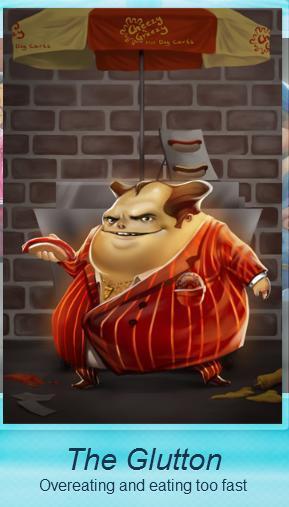
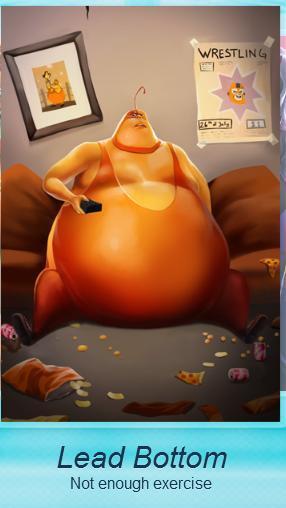
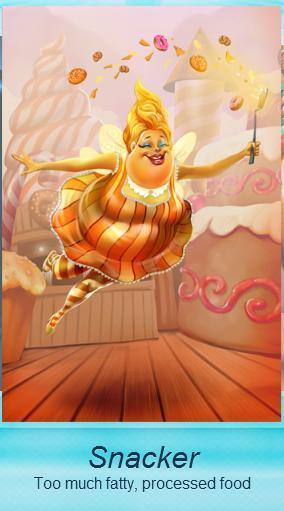
And Stink Bomb who is not only fat but has bad hygiene!
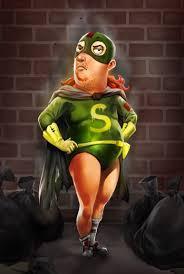
Lordy, lordy.
Let's pause for a minute and talk about why shaming fat kids is not just mean but ineffective as a weight-loss strategy (just in case you don't already know): In a letter addressed to blogger Shannon Russell the director of the National Institutes of Child Health and Human Development explained that programs like Disney's or the controversial Strong4Life campaign in Georgia:
…carry a great risk of increasing stigma for those children who are overweight or obese. which in turn can reinforce unhealthy behaviors (e.g., overeating). A number of research studies over the last decade have supported this concern. For example, studies suggest that overweight children who are teased about their appearance are more likely to binge eat or use unhealthy weight-control practices, and weight-based victimization ahs been correlated with lower levels of physical activity. Not surprisingly, stigmitazation of obese individuals, particularly adolescents, poses risks to their psychological health.
Other studies show that the perception that obesity is solely a matter of personal responsibility, as opposed to understanding the complexity of contributing factors, can increase negative stereotypes of overweight people. It is important, therefore, that public messages about obesity address this complexity wherever possible.
Perhaps it's no surprise that Disney couldn't address health risks of excess weight without making fat kids cry. In movie after movie—even the supposedly "enlightened" ones such as Beauty and the Beast or Tangled—fat (or "ugly" not to mention "old & female") in the Wonderful World has been used to signal character flaws: it's shorthand for stupid, ugly, comical, asexual, evil. For instance:
Ursula from Little Mermaid
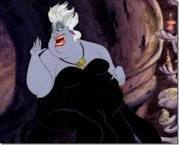
Aunt Sarah from Lady and the Tramp
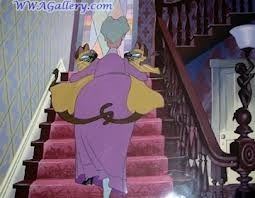
The Queen of Hearts in Alice in Wonderland
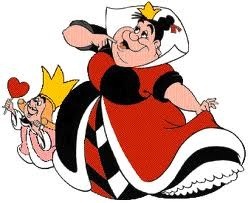
Mama Odie in Princess and the Frog (not villainous, but a weird)
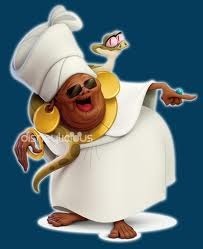
Ratcliffe in Pocahontas
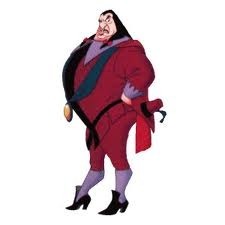
Stromboli from Pinocchio
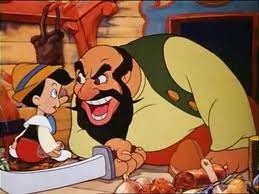
Smee from Peter Pan
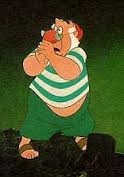
The list goes on. So you think this company is going to approach overweight children with the care, compassion and sensitivity they deserve?
A number of bloggers have taken this on (hence the pressure to close down the exhibit). But I haven't seen anyone discussing this part: Disney seemed to be trying to have its cake and shun kids for eating it, too. Because if the company really wanted to help in the fight against childhood obesity it would stop its pimping its characters out to be plastered on tasty, empty-caloried, ultra-processed, high-sugar foods that contribute to the problem. Tell me how Will Power would react, for instance, about Disney Princess Spaghetti O's?
[image error]
Or the Disney Princess "healthy kids" Campbell's soup, which, granted, contains 80 calories in a half cup serving (does anyone ever eat a half-cup serving?) but has virtually no nutritional value while dishing up 480 mg of sodium. Oh, and lest you forget, in tests of canned food by the Breast Cancer Fund the Disney Princess Cool Shapes, Shaped Pasta with Chicken Broth contained the second highest levels of BPA (a chemical linked to early puberty, breast cancer, prostate cancer, ADHD, type 2 diabetes and, oh yes–obesity) of any product tested.
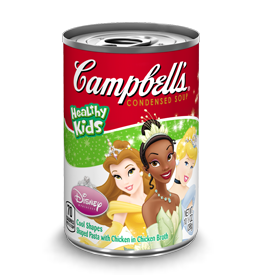
That's not to say Disney doesn't care about children's BPA levels when it suits them, otherwise they wouldn't advertise that their sippy cups and feeding sets for toddlers are BPA-free. How messed up is that?
Then there are the "Jewel Berry" Disney Princess Pop-Tarts. Jewel Berry?
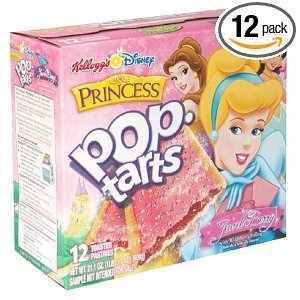
And the Princess Belle Fruit snacks which on the front promise "real fruit" but whose first two ingredients are corn syrup and sugar (that "real fruit" turns out to be apple juice puree).
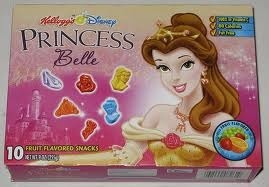
Speaking of fruit, the princesses also grace containers of apple juice, a beverage whose calorie and sugar content are precisely the same as soda pop and is similarly linked to childhood obesity.
[image error]
Though I suppose I should be careful what I wish for. It's not like I'd prefer Disney to start branding more healthful fare like vegetables or fruit. Oh, wait, they already have:
[image error]
Sigh. You know what I think would be really great? If the company made films in which the protagonists were themselves a healthy weight—that is, not impossibly narrow-wasted and large-breasted—and in which fat characters (girls and women in particular) were neither the subject of ridicule or disdain. Maybe one could even get the prince.
[image error]
February 22, 2012
Who Needs Lego Friends When You Have a Lego Granddaughter?
A reader named Leslie, whose daughter, Callie's eloquent letter about Lego's new "Friends" line was summarily dismissed by that company, just sent me this photo:
Callie and her cousins made this Lego "birthday cake" for their grandmother, who is unable to eat the real deal. Here's the family of girls and women preparing to blow out the candles. I bet they wished for creative, open-ended toys that didn't stereotype and hyper-segment children.
And guess what, Lego? THIS IS WHAT BEAUTIFUL LOOKS LIKE!!!!!!
February 13, 2012
C*O*N*T*E*S*T* W*I*N*N*E*R*S!!
Last week my publisher ran a contest on my facebook author page in which readers posted examples of the "princess industrial complex" run amok.
I could not POSSIBLY choose only three from the bounty posted. So I wheedled an extra couple of books out of my publisher. I wish I could put a winner's wreath (NOT a crown!) on everyone because each entry illustrated the reach and impact of princess/diva culture on younger and younger girls. You can see all entries by scrolling down the facebook page and hitting "older posts."
Meanwhile, would the winners please email your addresses to my publisher at: Erica.Barmash AT harpercollins.com to claim your prizes!Now, drum roll:GRAND PRIZE (signed copy of CAMD; a copy of Girls Like Us and a Harpercollins book tote): For Illustrating How Bombardment By Princess Products has Undermined Little Girls' Imaginations and Flattened their Individuality:
Beth Tischler Becker. When the children in her daughter's class "disguised" a flock of paper turkeys for Thanksgiving, the boys came up with a range of ideas—turkeys dressed as baseball players, Spiderman, grass(!). Every. Single. Girl (with the exception of Beth's own) decorated her bird as a princess. 4 out of 6 chose Disney Princesses. Limited, much? Beth also posted the Charlotte La Bouff doll— she's the white girl from "Princess and the Frog," who has, unlike secondary characters in any other Princess movie, apparently been elevated to princess status; the pending Eden Wood fashion line (so your daughter, too, can dress like the "Toddlers & Tiaras" star!!); and the Disney Princess "pop art toaster," which imprints crowns etc. onto your daughter's bread). Beth, seems like you could've written "Cinderella Ate My Daughter" yourself!
[image error]
RUNNER UP (signed copy of CAMD): Start 'em Early:
Katie Miller for submitting Fisher Price's "Brilliant Basics" girls' and boys' teething ring/rattles which highlight both gender hyper-segmenting and the downward creep of Kardashianization: The set for your "darling baby girl" features a purse, diamond ring and charm bracelet; your boy gets a saw, hammer and wrenches.
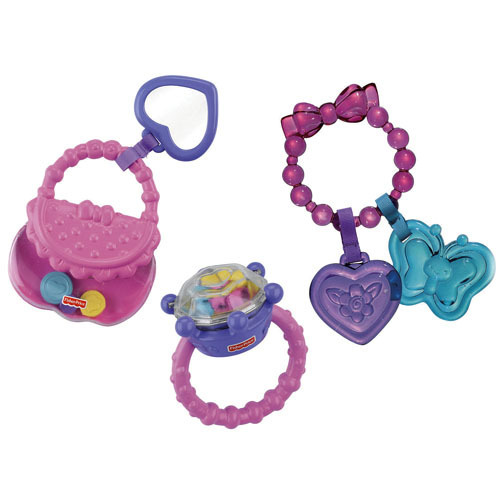
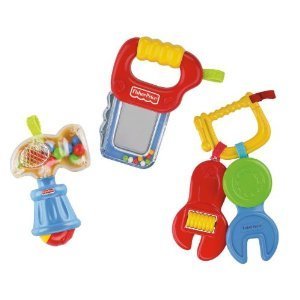
RUNNER UP (signed copy of CAMD): Princesses Need to be White and Blonde
Melissa Pantel-Ku for the Melissa & Doug hand mirror surrounded by (straight) blonde hair topped by a tiara. Note, that Melissa & Doug, with its old-fashioned, wooden toy ethos purports to be the more wholesome alternative to Disney and Mattel.
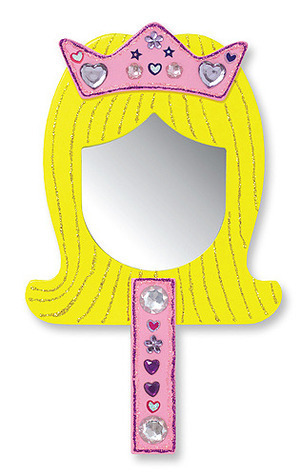
RUNNER UP (signed copy of CAMD): Girls Will Only Like Math if They Think it's Pretty:
Terri Wiley for the Princess Math app. (For more on this issue see my post "Science Sans Sexism")
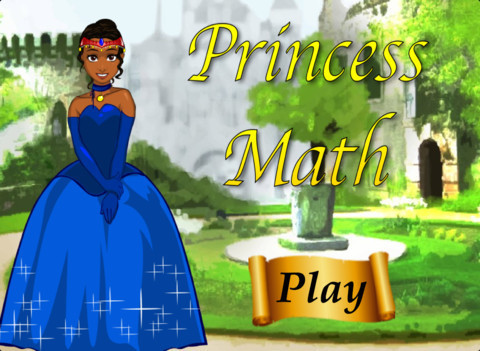 RUNNER UP (signed copy of CAMD): Product that Only the Parents of an ACTUAL Princess Could Afford:
RUNNER UP (signed copy of CAMD): Product that Only the Parents of an ACTUAL Princess Could Afford: Hyphen Dorothy HP for the $47,000 pink princess Fantasy Coach bed.
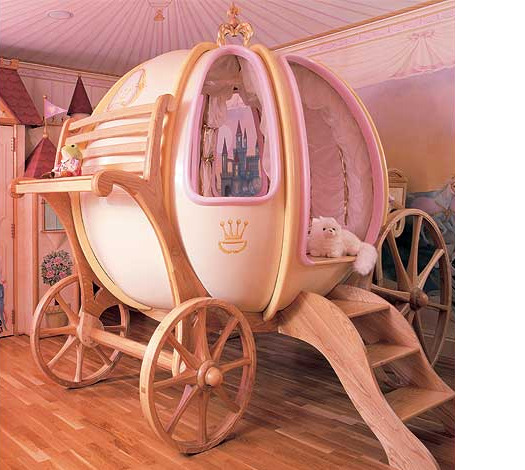
RUNNER UP (signed copy of CAMD): For Making My Jaw Hit the Floor
Sarah Lozoff for her photo of a female firefighter at Legoland (built out of LEGOS) who is putting on lipstick rather than battling blazes (the male police officer next to her is speaking into a walkie talkie).
[image error]
Peggy Orenstein's Blog
- Peggy Orenstein's profile
- 722 followers


